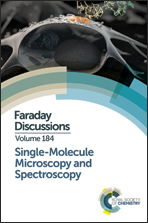Multicolour single molecule emission and excitation spectroscopy reveals extensive spectral shifts
Abstract
We explore the distribution and shape of single molecule spectra at room temperature, when embedded in a polymer host. Multicolour excitation and emission spectroscopy is implemented to capture the full inhomogeneous distribution. We observe dramatic spectral changes in a distribution of single quaterrylene diimide (QDI) molecules isolated in a PMMA matrix. The molecules are strongly blue shifted with respect to the ensemble absorption maximum and spread over a staggering 200 nm range. Despite these strong shifts, the shape of the emission spectra does not differ much between individual molecules. We demonstrate that a considerable number of molecules may be invisible in single molecule experiments, as they typically rely on only a single excitation wavelength, which predetermines which subensemble is probed in the experiment. Lastly, we make a first step towards single molecule excitation spectroscopy under ambient conditions, which allows us to determine the spectral range at which individual molecules absorb light most efficiently. We show how single molecule emission and excitation spectroscopies can complement each other and a combination of both techniques can help in understanding the origin of underlaying spectral properties of individual molecules.
- This article is part of the themed collection: Single-Molecule Microscopy and Spectroscopy


 Please wait while we load your content...
Please wait while we load your content...